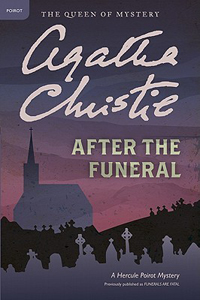Fans who delight in Agatha Christie’s internal tropes will love “Funerals are Fatal” (1953, a.k.a. “After the Funeral”). It’s a page-turner with a family full of suspects – some of them memorably colorful. Poirot goes undercover and is disappointed that people aren’t more impressed when he reveals his identity – but he doesn’t let that stop him from doing his job.
Sprawling suspect list
For the same reasons, “Funerals” could be a decent first novel for a Christie reader – maybe a fan of “Knives Out” who is curious about that film’s inspirations. My only reservation is that this family is so sprawling that it’s hard to keep track of who’s who. The dramatis personae and family tree in the opening pages prove valuable.
I was poised to particularly enjoy Cora Lansquenet, who – despite being middle-aged – is known for blurting out things like a child. She’s what we now call socially challenged. But Poirot and the sharp Mr. Entwhistle – the family’s lawyer – note that Cora has a tendency to tell truths that other people keep silent about.

“Funerals are Fatal” (1953)
Also published as: “After the Funeral”
Author: Agatha Christie
Genre: Mystery
Series: Hercule Poirot No. 33
Setting: Enderby Hall, England, 1953
At the funeral of patriarch Richard Abernathie, who supposedly died of an illness, sister Cora states: “But he was murdered, wasn’t he?”
This simple but bizarre statement sends multiple investigators prowling and sends Abernathie’s heirs (Cora plus invalid brother Timothy, plus several nieces and nephews, plus spouses) into a tizzy.
Poirot (and pals) on the prowl
“Funerals” is a classic case of Poirot letting the answers come to him. By spending time around the Abernathies (in the guise of a prospective buyer of their mansion), asking questions and observing them, he believes he’ll learn whether Richard was indeed murdered.
Christie has hinted through the years that Poirot has helpers he can call on, but “Funerals are Fatal” gives a rare clear example. Mr. Goby, a brilliant gatherer of information, gives Poirot thorough dossiers on every member of the Abernathie clan.
Goby lines up alongside Cora and the somewhat flighty Rosamund and one other character (to be explored after the spoiler warning) as an atypical personality. He doesn’t make eye contact when speaking with Poirot.
Poirot covers his bases here, but Christie doesn’t let him off so easily. She undercuts one of the accepted tenets of British family mysteries: the motive of monetary gain.
No heir particularly benefits from Richard’s death, as he has treated his heirs equally and they all get equal inheritances. So why would anyone murder Richard if they don’t benefit?
(SPOILERS FOLLOW.)
Mulling motives
The second murder – of Cora herself – further convinces the multiple sleuths that she was telling the truth about Richard being murdered. Miss Gilchrist, Cora’s “companion” (live-in housekeeper), has means and opportunity, but she doesn’t gain much from Cora’s death.

But as it turns out, Gilchrist acquires a reasonably valuable painting of Cora’s and this will be enough to reopen a tea shop. She’s not noticeably crazy – not like one of those theoretical “tramps” that everyone except Poirot immediately suspects in every Christie book.
But she is willing to kill to get that tea shop. It’s a minor gain to an outsider’s viewpoint, but it’s Gilchrist’s whole world.
In this way, “Funerals” is a more plausible spin on the theme of “Murder is Easy.” That book posits that it’s easy to get away with murder if you have no motive. But it’s more of a thought experiment. In “Funerals,” Christie comes to her point in organic fashion.
You never truly know someone
Granted, the plausibility here is debatable, once we learn the complexity of Gilchrist’s scheme.
By midcentury, Christie’s novels had begun to be adapted. (“Funerals” became “Murder at the Gallop” in 1963, with – for some bizarre reason — Marple replacing Poirot.)
I wonder if Christie enjoyed toying with adapters by doing things that work well in novels but aren’t easy to translate. As it turns out, Gilchrist was posing as Cora when she announced “But he was murdered, wasn’t he?”
It’s believable in the book’s context, as Cora had been estranged from the other Abernathies for decades and Gilchrist put in the work to mimic her.
But, even more so than “Murder with Mirrors” (which also features trickery via impersonation), I wonder how this can be translated to the screen without an immediate giveaway. I’ll be interested to find out when I get to the “Poirot” TV series’ take on “Funerals are Fatal.”
On the page, it’s somewhere between a brilliant twist and silly fun.
Every week, Sleuthing Sunday reviews an Agatha Christie book or adaptation. Click here to visit our Agatha Christie Zone.


The problem is that you’ll have no way of knowing how effective the deception is in the screen version, due to the problem of what psychologists refer to as the “curse of knowledge.” That is, short of amnesia, it’s impossible to place yourself in a state of pre-knowledge innocence. Knowing what to look for, you will see the deception.
That would be true if I watched a screen version of “Funerals are Fatal” immediately. But if I don’t see it until years down the road, it’s possible I would’ve forgotten about the twist. 🙂